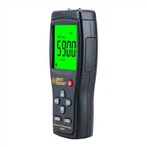What elements affect an infrared thermometer's accuracy?
prevailing temperature
The use of infrared thermometers must strictly follow the ambient temperature as reported by the instrument's technical indicators. If it goes over this range, the instrument's measuring error will worsen or perhaps get harmed. Use of air-cooled, water-cooled, or thermal protection jackets in hot conditions can keep an instrument functioning normally in temperatures up to 200 °C.
The accuracy of the instrument will temporarily decrease when the infrared thermometer is used in an environment where there is a significant variation in ambient temperature from one environment to another. The instrument should be left on the job site for a period of time (recommended At least 30 minutes) to allow the instrument temperature and ambient temperature to reach equilibrium before use in order to acquire excellent temperature measurement results.
air quality
Smoke, dust, and other air pollutants, in addition to dirty lenses, will prohibit the instrument from receiving sufficient infrared energy to fulfill the measurement precision, resulting in an increase in the measurement error of the device. As a result, the lens may be kept clean frequently, and the air blower aids in keeping the lens contaminant-free.
environmental radiation
Measurement mistakes occur when the measured target is surrounded by other high-temperature items, light sources, or solar radiation. These radiations might enter the optical path of the measurement directly or indirectly. In order to reduce the impact of environmental radiation, it is first required to prevent environmental radiation from entering the optical path directly. Moreover, the measured target should occupy as much of the instrument's field of vision as feasible. The shielding technique can be utilized to get rid of ambient radiation's indirect interference.
electromagnetic interference
The instrument should be placed as far away from potential electrical interference sources as is practical, such as electrical equipment with significant load fluctuations. The online instrument's output and input connections make use of shielded wires and make sure they are properly grounded. Use external protective conduit in high interference conditions; stiff conduit is preferable to flexible conduit. Avoid feeding AC power into the same conduit from other pieces of equipment.
measuring angle
In order to ensure accurate measurement, the instrument should try to measure along the normal direction of the surface of the measured object (perpendicular to the surface of the measured object) when measuring. If it cannot be guaranteed to be in the normal direction, it should also be measured within a 45° angle to the normal direction, otherwise the instrument display value will be low.
Field of view and target size, to ensure that the target enters the measuring field of view of the instrument. The smaller the target, the closer it should be. In actual measurement, in order to reduce the error, generally the size of the target should be more than twice the size of the spot in the field of view.






